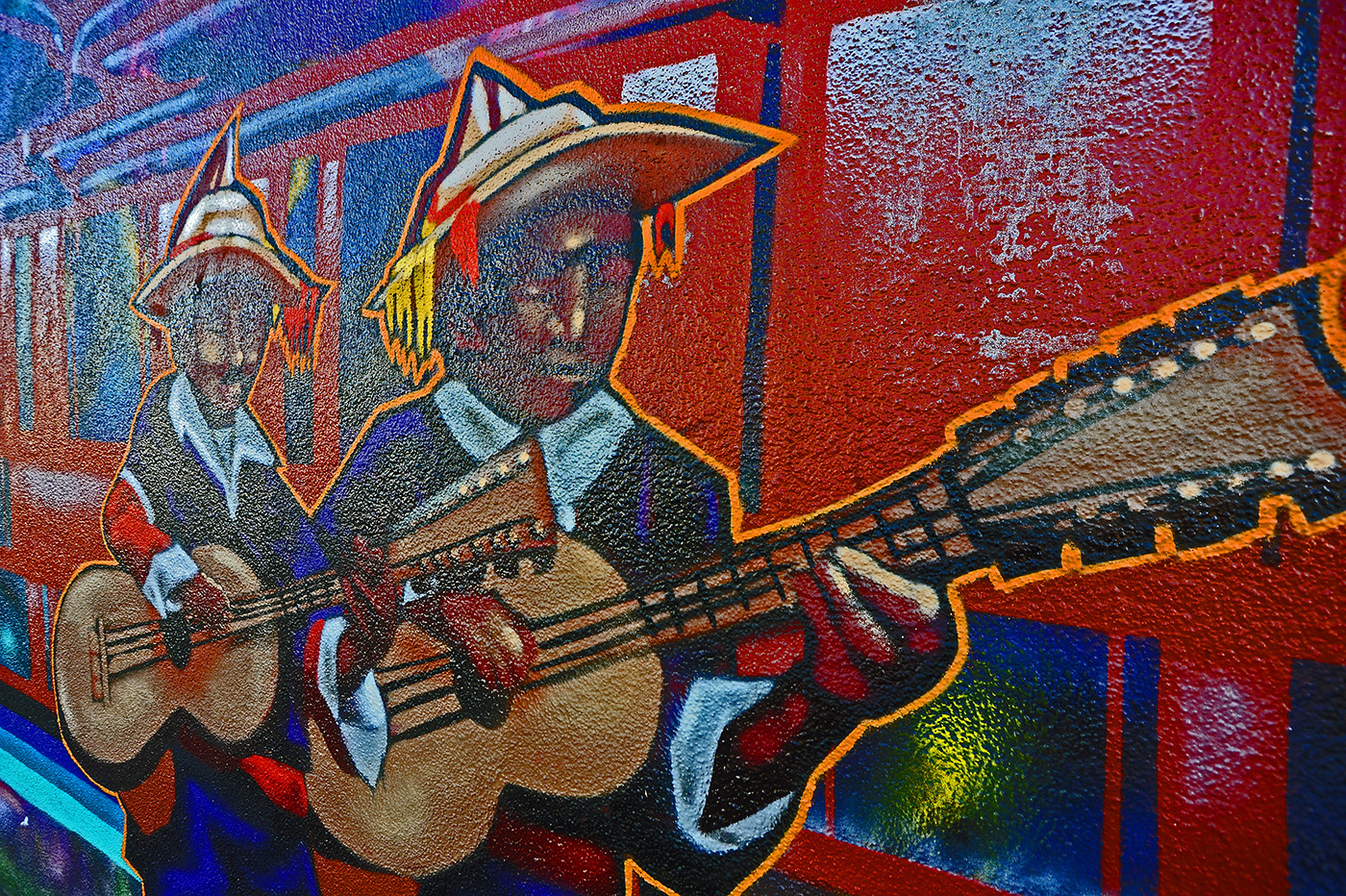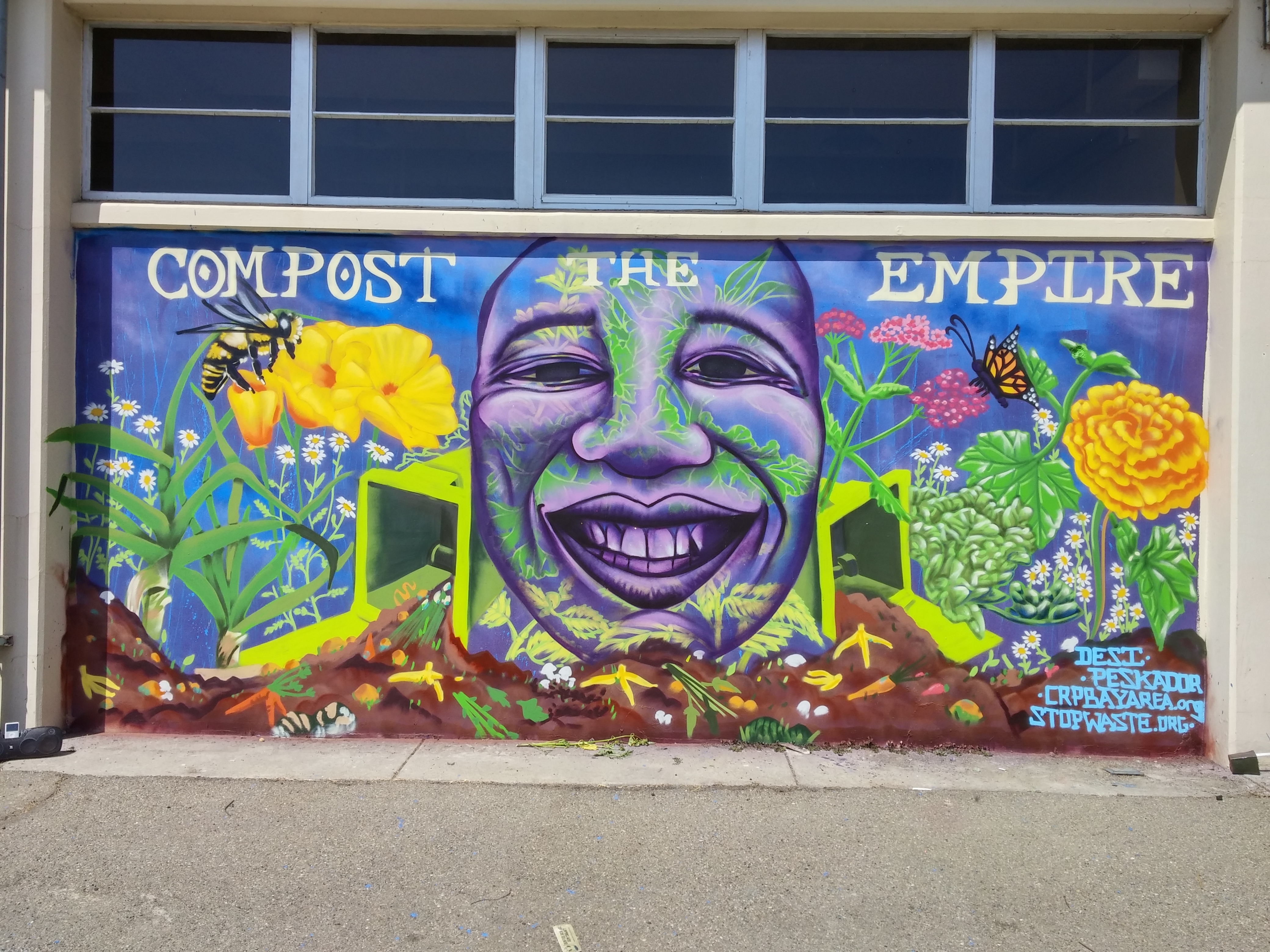
A growing body of research has positively identified murals with social, cultural, and economic benefits as well as positive mental health. Murals have the added benefit of intersectionality, meaning they promote these characteristics simultaneously, in a synergistic way. Some specific ways in which murals are beneficent include:
Public Art
- Murals offer accessibility to art and creative expression without the cost and class-based barriers associated with museums and galleries, as well as architectural integration into the physical environment.
- In addition, public art initiatives have been identified as an equity-advancement strategy for economic development of populations at risk of displacement.
Aesthetics
- Through the visual aesthetic, murals promote a sense of Identity, belonging, attachment, welcoming, and openness, and strengthen community identification to place.

This mural, on the Richmond Greenway, was part of an urban redevelopment effort which encouraged biking, walking, and use of public space.
Creative Placemaking
- Many Creative Placemaking initiatives revolve around public art, and murals in particular are highly-effective tools, because of their physical integration into their environment, and their many aesthetic benefits.
- Murals create a tangible sense of place, destination, resulting in increased foot traffic while adding color, vibrancy, and character to urban environment. Murals contrast the negative mental health effects of concrete and asphalt, and can have therapeutic benefits for mentally-ill and homeless populations. Additionally, multiple murals in a retail corridor can creates a visible sense of being in an an arts district or cultural corridor.
- While some Placemaking initiatives have raised concerns about advancing gentrification, by centering equity as a core value and integrating community stakeholder input and participation into the process, the opposite outcome can be emphasized and achieved. Recent studies, in fact, have linked arts and culture to equitable development.

This mural of community activist Mother Wright is part of Creative Placemaking initiative by the People’s Grocery in West Oakland.
Creative Placekeeping
- Murals can also be instrumental to Creative Placekeeping, which differs from Creative Placemaking in that engagement and activities are ongoing and incorporate active curation of a mural site. Historical examples of this include the Wall of Respect in Chicago and Clarion Alley in San Francisco.
- CRP murals have served as the backdrop for music videos, mural tours and art walks, block parties and community celebrations, and have inspired panel discussions, symposia, and documentary and multimedia projects. There is no limit to what Creative Placekeeping activities can entail, except one’s own imagination.
Public safety
- Murals are examples of the controversial “broken windows” theory in reverse – enhancing public safety by creating a feeling that a location is cared for, which in turn makes crimes of opportunity — such as vandalism, illegal dumping, drug use, and robbery — less-likely.
- For example, murals which address gun violence humanize, rather than dehumanize, victims, creating emotional resonance rather than numbing emotions.

This memorial mural, which lists names of victims of gun violence in Oakland, has helped to calm down a neighborhood hotspot.
Abatement
- Murals can effect tag mitigation, and deter tag recidivism. In addition to a beautification advantage over simple abatement—murals are simply more attractive to look at than blank walls—they can also offer significant long-term cost savings in vandalism hotspots and generally require only minor maintenance when best practice methods (such as clear-coating) are employed.
- To learn more about abatement and alternatives, click here.

The Peace and Dignity mural in Oakland’s Fruitvale District was funded by the Redevelopment Agency as part of a blight mitigation initiative.
Uphold public art objectives and goals
- Public Art programs are intended to increase the quality of life for all residents of a city, while Cultural Affairs Departments often have core values of celebrating diversity and life enrichment. Murals are definitive example of public art which can perfectly align with these goals and values.
Youth development

An ArrowSoul Student poses with his first piece.
- Mural initiatives have been used in many cities to promote youth development and youth-led programs.
- Murals have also been used in the development of youth-oriented curricula in education.
Facilitate public-private partnerships and collaborations

Kiazi Malonga, Mayor Jean Quan, Cephus Johnson, Carla service, Pancho Peskador, and Desi Mundo at the Alice st. mural ribbon-cutting ceremony.
- Murals can connects artists, community organizations, non-profits, small business, BIDS, community development corporations, developers, government agencies, educational and cultural institutions, etc., in collaborative creative engagement projects.
Messaging / Social Consciousness / Equity
- Murals can also promote equitable outcomes for historically-underserved or disadvantaged populations.

Murals can provide the messaging for social movements.
Blight mitigation
- Murals transform blighted areas in urban cities, and are a relatively-inexpensive method of urban redevelopment which are particularly effective in blighted areas, especially those in the inner-city. This, in turn, helps maintain property values while also deterring crime, such as illegal dumping and drug use. murals can also be combined with streetscaping projects.
Tourism, commerce (in commercial areas)
- Mural programs have been used as economic development initiatives, with the goal of increasing tourism by making commercial retail sectors more attractive destinations for visitors, as well as local residents.

Murals can be a catalyst for community-building.
Sustainability / Resilience
- Murals add a creative aesthetic to the built environment, which energizes neglected or blighted neighborhoods, and enhances districts where new development is taking place by creating a sense of destination.
- When linked to cultural preservation efforts, murals can also highlight diversity and resilience initiatives.

This mural was commissioned by StopWaste.org to increase awareness of environmental issues.
